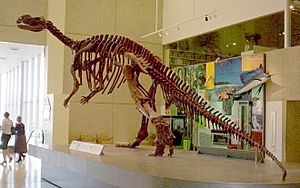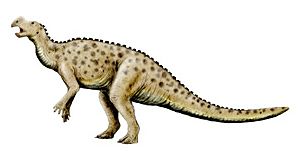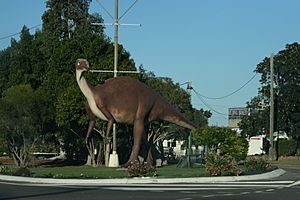Muttaburrasaurus facts for kids
Quick facts for kids MuttaburrasaurusTemporal range: Early Cretaceous
|
|
|---|---|
 |
|
| Skeleton at the Queensland Museum | |
| Scientific classification | |
| Kingdom: | |
| Phylum: | |
| Class: | |
| Superorder: | |
| Order: | |
| Infraorder: | |
| Family: | |
| Genus: |
Muttaburrasaurus
Bartholomai & Molnar, 1981
|
| Species | |
|
M. langdoni Bartholomai & Molnar, 1981 (type) |
|
The Muttaburrasaurus was a large plant-eating dinosaur. It lived during the middle Cretaceous period, about 113 to 97.5 million years ago. Its name means "Muttaburra (in Queensland, Australia) lizard," after the place where its fossils were found. This dinosaur grew to be about 24 feet (7 meters) long. Scientists think Muttaburrasaurus might have lived in groups or herds.
Contents
What did Muttaburrasaurus look like?
Muttaburrasaurus was about 26 feet (8 meters) long. It weighed around 2.8 metric tons, which is like two small cars. The main thigh bone (called a femur) of the first found skeleton was over 3 feet (1 meter) long.
Scientists have discussed how Muttaburrasaurus moved. It was first thought to be an "Iguanodontid," which are dinosaurs that could walk on four legs. However, newer studies suggest it was a more basic type of Ornithopod. These early ornithopods usually walked only on two legs. At first, it was thought that Muttaburrasaurus had a spike on its thumb, like some other dinosaurs. But later, scientists doubted it had such a spike. Its foot was long and wide, with four toes.
The unique Muttaburrasaurus skull
The skull of Muttaburrasaurus was quite flat. From above, it looked like a triangle. The back of its head was wide, but its snout was pointed. The snout had a large, hollow, bulging area that stuck upwards. This part might have been used to make loud calls or to show off to other dinosaurs. However, because no soft tissue from its nose has been found, this is just a guess. This special nose area was shorter in older Muttaburrasaurus species.
How was Muttaburrasaurus discovered?
The first parts of Muttaburrasaurus were found in 1963. A farmer named Doug Langdon discovered a partial skeleton. He found it at Rosebery Downs Station, next to the Thomson River near Muttaburra, in Queensland, Australia. This place gave the dinosaur its name.
Paleontologist Dr. Alan Bartholomai and entomologist Edward Dahms collected the bones. After a lot of work to prepare the fossils, the dinosaur was officially named in 1981. Bartholomai and Ralph Molnar named it Muttaburrasaurus langdoni. They chose langdoni to honor Doug Langdon, who found it.
Important fossil finds
The first skeleton found, called the holotype, is known as specimen QM F6140. It was found in rock layers from the Albian-Cenomanian ages. This fossil included a partial skeleton with its skull and lower jaws. Parts of the skull, jaw, many backbones, hip bones, and parts of the front and back legs were preserved.

Some teeth have been found further north, near Hughenden. Others were found south at Lightning Ridge, in New South Wales. At Lightning Ridge, scientists even found opalized teeth and a shoulder blade that might belong to a Muttaburrasaurus.
In 1987, another skull was found by John Stewart-Moore and 14-year-old Robert Walker. This skull, called the "Dunluce Skull" (specimen QM F14921), was found between Hughenden and Richmond. It came from older rock layers. Molnar thought this might be a different, unnamed species of Muttaburrasaurus. Two more partial skeletons were found in the same area in 1989. Also, single teeth and bones have been found in other locations.
You can see reconstructed skeletons of Muttaburrasaurus in several museums. These include the Queensland Museum, Flinders Discovery Centre, and National Dinosaur Museum in Australia.
See also
 In Spanish: Muttaburrasaurus langdoni para niños
In Spanish: Muttaburrasaurus langdoni para niños




